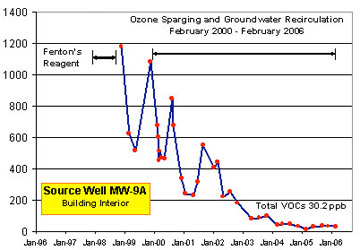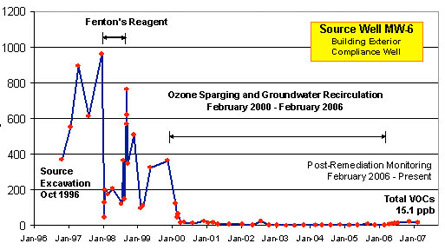|
Ozone Sparging Closure of an Industrial VOC Spill Site Adjacent to a Water Supply Well Site*
William B. Kerfoot1 Bruce Ehleringer2 and John Muncy3
1Kerfoot Technologies, Inc., 766-B Falmouth Rd., Mashpee, MA 02649
2Washington Group International, 1500 West 3rd St., Cleveland, OH 44113
3REM Investments, Enon, OH
Description
An undocumented surface spill at an active manufacturing facility located adjacent to a public water supply well field released chlorinated volatile organic compounds (PCE, and its breakdown products: TCE, c-DCE, and VC) into soils and groundwater. The driver for site cleanup was three water supply wells located 200 feet downgradient of the site bounds. The chosen endpoint remediation technology was ozone sparging employing the KTI C-Sparge™ process to reach the target cleanup criteria of EPA MCLs for water supply protection.
The site was comprised of fluvial sand and gravel deposits with discontinuous silt lenses and depth to groundwater at 5 feet. Hydraulic conductivity of over 200 feet per day occurred in deeper sand and gravel deposits. Silt lenses near the surface caused perched water conditions during heavy rainfalls.
Prior remedial actions included source excavation (1996) and Fenton’s Reagent flooding of the surface and shallow groundwater (top 8 feet) in 1998, which was discontinued for several reasons including potential reagent flooding of the surface and vapor migration through concrete floor joints, as well as cost of necessary multiple injections. At this point, four alternative remedial actions were considered: monitored natural attenuation, phytoremediation, bioremediation by anaerobic supplements and in-situ oxidation using ozone sparging with groundwater recirculation.
Ozone sparging, begun in February 2000, was selected for numerous reasons: rapid decomposition of PCE, TCE, DCE, and VC, with no harmful byproduct production; not disruptive to facility operations; dosage adjustable to accelerate remaining cleanup at targeted points; and regulator choice. Spargepoints® were installed along a wall inside a warehouse addition to a depth of 8 feet below static water, since it was determined that contamination had spread under the concrete slab. Two recirculation well Spargepoints® were placed 30 feet below the water table outdoors near a loading dock in the previously-treated zone. Releases into the building were avoided by a negative pressure system isolating both the small wallmount C-Sparge™ system and the distribution tubing.
Results
By the end of 2001, groundwater volatile organic compound concentrations in one downgradient well decreased by about 95 percent. Additional Spargepoints® were installed near the property boundary in December 2002. At the downgradient property line total VOCs decreased from 360 ppb in January, 1999 to less than 10 ppb in early January, 2005 (shallow 15-foot deep monitoring well), with less than 5 ppb in the deeper (25-foot) monitoring well. No VOCs were detected in any municipal water well samples, with the exception of one well at approximately 1 ppb PCE. The treatment system operation was discontinued in 2006, but sampling continued for the compliance well. Although a slight rise occurred in the compliance well at the end of 2006 near the building exterior source, by February, 2007 all VOC levels were below MCLs except for TCE, which exceeded the MCL 5.0 µg/L at 5.2µg/L. All VOC concentrations at the boundary and wellsite were below MCLs. The site is at post-remediation stage, with quarterly monitoring.
 
* Presented at 2007 World Congress on Ozone and Ultraviolet Technologies, International Ozone Association, Los Angeles, CA, August 27-29, 2007
|